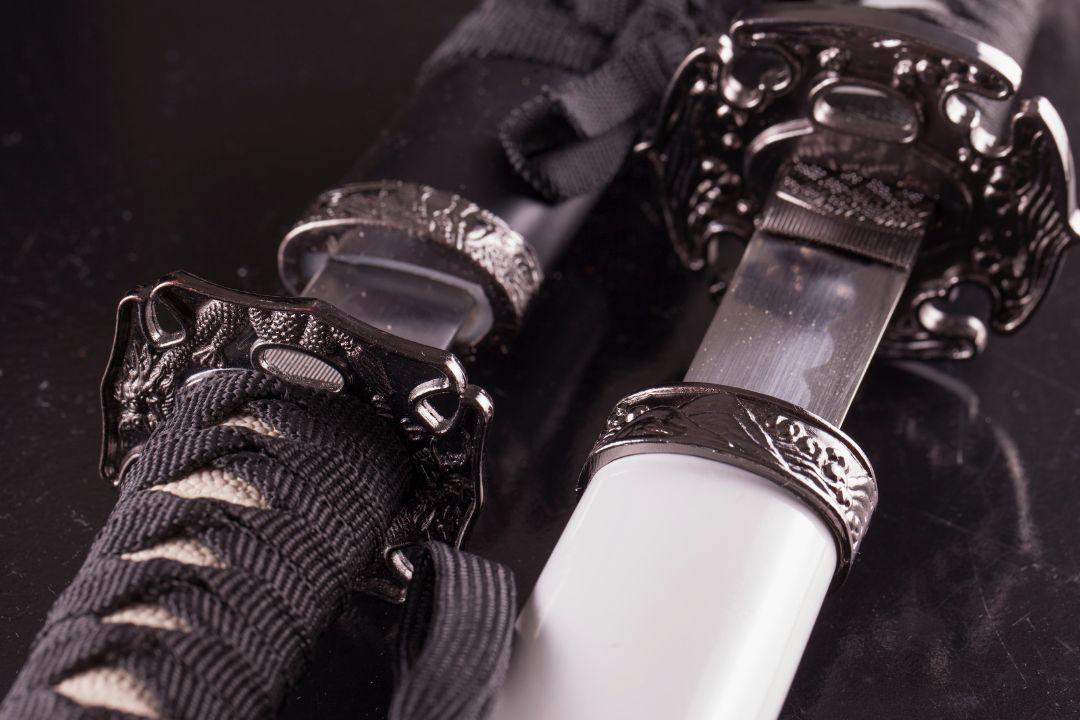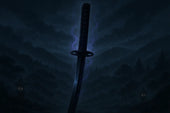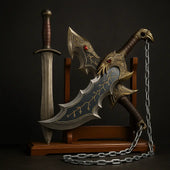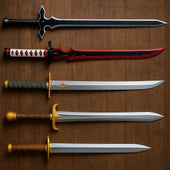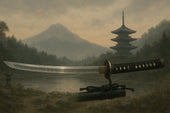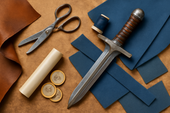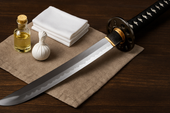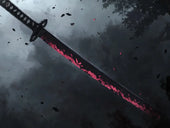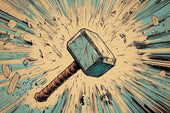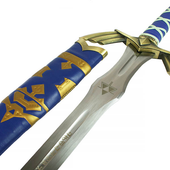The katana sword is one of the most iconic swords in history, known for its razor-sharp edge and exceptional cutting ability. But how sharp is a katana, really? Unlike ordinary knives, a katana’s edge is the product of centuries-old forging techniques that optimise its slicing power. From its distinct curvature to the meticulous sharpening process, this sword is a marvel of craftsmanship. In this guide, we’ll explore what makes a katana blade so sharp, how it compares to other weapons, and how to maintain its legendary edge.
What Makes a Katana Sharp?
The katana’s sharpness is a result of its design, differential hardening process, and expert polishing techniques. Each of these factors contributes to its renowned cutting efficiency.
Curved Blade for Enhanced Slicing
A katana’s subtle curvature is not just for aesthetics—it plays a crucial role in its cutting ability. The curve helps reduce friction and resistance, allowing for smoother, more effective slices. This design is especially advantageous in combat, enabling swift, clean cuts with minimal effort.
Differential Hardening for a Razor-Edge
A key feature of a katana is its differential hardening process, achieved through clay tempering. Swordsmiths apply clay to the spine of the blade before heating and cooling it. The edge, exposed to rapid cooling, becomes exceptionally hard, while the spine remains flexible. A clay tempered blade is not only razor-sharp but also resilient, preventing breakage under heavy use.
Hand-Polishing with Water Stones
The final step in refining a katana’s edge is an intricate hand-polishing process. Skilled artisans use progressively finer water stones to sharpen and smooth the blade, ensuring its peak performance. This painstaking method enhances the hand-forged sword cutting ability, allowing it to slice through materials like bamboo and tatami mats with ease.
How Does a Katana’s Sharpness Compare to Other Blades?
The katana’s edge is distinct from other swords and knives, making it uniquely suited for precise, powerful cuts.
Katana vs. Modern Knives
Unlike kitchen knives, which are designed for slicing or chopping, the katana is engineered for fluid, continuous cuts. While a chef’s knife has a razor-sharp edge for delicate food preparation, it lacks the katana’s curved design and steel composition, which are optimised for cutting through thicker materials.
Katana vs. European Swords
European swords, such as the longsword, are typically double-edged and designed for hacking and thrusting. In contrast, the katana’s single-edged convex blade allows for precision and smooth slicing. While a longsword delivers powerful blows, a katana is crafted for quick, clean strikes that maintain momentum through a target.
The Science Behind the Katana’s Edge
The convex shape of a katana’s edge distributes force efficiently when cutting, allowing it to slice deeper without getting stuck. This is why a katana can cut through soft to medium-density materials with remarkable ease, unlike flat-edged blades that may require more force.
Traditional Forging and Sharpening Techniques
The katana’s legendary sharpness is rooted in ancient Japanese forging techniques that enhance its durability and edge retention.
Tamahagane Steel: The Heart of the Blade
Authentic katanas are forged from tamahagane steel, a high-carbon steel made in traditional furnaces. This steel is carefully folded and hammered to remove impurities, resulting in a blade that is both strong and flexible—a crucial factor for maintaining sharpness over time.
Clay Tempering and the Hamon Line
During the clay tempering process, the blade is coated with a special clay mixture before being heated and cooled. This process creates the hamon, a distinct wavy line along the edge that not only adds visual beauty but also indicates a properly tempered sword. The hard edge remains sharp for longer, while the softer spine absorbs shocks, reducing the risk of breakage.
Hand-Polishing for Razor Precision
Polishing a katana is an art in itself. Expert polishers use a series of fine-grit water stones to hone the edge to razor-sharp precision. This process can take weeks, as each layer of polish refines the blade’s sharpness and aesthetic appeal.
Can a Katana Cut Through Anything? Myths vs. Reality
Many myths surround the katana’s cutting ability, with some suggesting that it can slice through metal or stone. Let’s separate fact from fiction.
Myth: A Katana Can Cut Through Metal
Despite its sharpness, a katana is not designed to cut through steel or armour. While it can deliver devastating cuts to soft materials, attempting to slice through metal can damage or chip the blade.
Reality: A Katana Excels at Test Cutting (Tameshigiri)
Historically, katanas were tested on bamboo, tatami mats, and even human cadavers to assess their sharpness. Today, test cutting (tameshigiri) involves slicing through rolled-up tatami mats or green bamboo, both of which simulate the density of a human limb. A well-forged katana can slice through these materials effortlessly.
How to Maintain a Katana’s Sharpness
Owning a katana comes with the responsibility of proper maintenance to preserve its cutting ability.
Regular Katana Cleaning and Oiling
To prevent rust and corrosion, clean your katana after each use. Apply a light coat of choji oil (traditional mineral oil) to protect the blade.
Sharpening the Edge of your Katana
Sharpening a katana is a delicate process that should be done with traditional water stones. Unlike sharpening a knife, a katana’s edge requires precise angle control to maintain its integrity.
Storing your Katana
Store your katana in a wooden scabbard (saya) and keep it in a dry, cool environment. Excessive moisture can lead to rust, while improper handling may dull the blade over time.
The katana is an exceptionally sharp weapon, renowned for its precision and cutting power. Its curved design, differential hardening, and meticulous polishing make it one of the sharpest swords ever crafted. However, its true cutting ability is best appreciated when used correctly—against appropriate materials, with proper technique, and under expert care.
Whether you’re a collector, martial artist, or history enthusiast, understanding the science and craftsmanship behind a katana’s edge deepens your appreciation for this legendary blade. If you own a katana, maintaining its sharpness is essential to preserving its function and beauty for generations to come.


